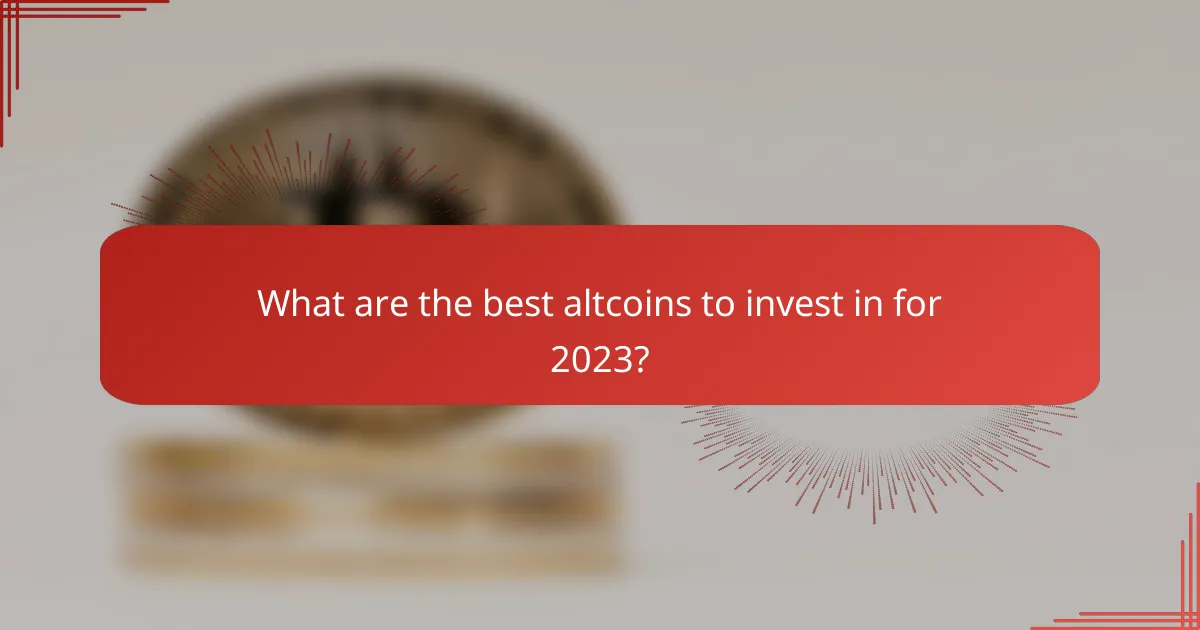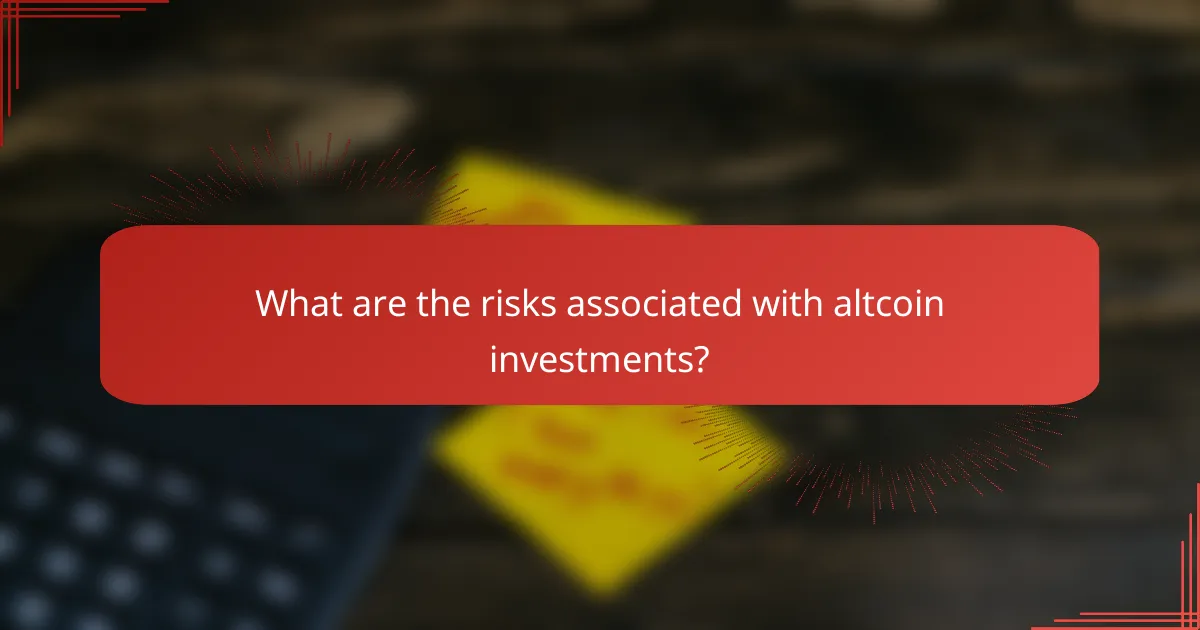The altcoin market is experiencing a notable transformation, characterized by heightened adoption and investment fueled by factors such as institutional interest and the expansion of decentralized finance (DeFi) and non-fungible tokens (NFTs). As alternative cryptocurrencies, altcoins present diverse functionalities and investment opportunities that can attract a wide range of investors. Understanding current market trends is essential for those looking to effectively navigate this evolving landscape.

What are the current market trends for altcoins?
Current market trends for altcoins indicate a significant shift towards increased adoption and investment, driven by various factors such as institutional interest, decentralized finance (DeFi) growth, and the rise of non-fungible tokens (NFTs). Understanding these trends is crucial for investors looking to navigate the altcoin landscape effectively.
Increased institutional investment
Institutional investment in altcoins has surged, reflecting a growing acceptance of cryptocurrencies as viable assets. Major financial institutions and hedge funds are diversifying their portfolios by allocating funds to altcoins, which can offer higher returns compared to traditional assets.
For investors, this trend suggests a maturing market where altcoins are increasingly viewed as legitimate investment opportunities. Monitoring institutional activity can provide insights into which altcoins may gain traction in the future.
Growing DeFi adoption
The decentralized finance (DeFi) sector is rapidly expanding, with altcoins playing a pivotal role in this growth. DeFi platforms allow users to lend, borrow, and trade without intermediaries, often using altcoins as collateral or for transactions.
Investors should consider exploring altcoins that are integral to popular DeFi protocols, as these may experience increased demand. However, it’s essential to assess the risks associated with DeFi, including smart contract vulnerabilities and market fluctuations.
Emergence of NFTs
The rise of non-fungible tokens (NFTs) has created new opportunities for altcoins, particularly those that support NFT marketplaces and transactions. Altcoins like Ethereum have become the backbone of the NFT ecosystem, facilitating the creation and trading of unique digital assets.
Investors interested in NFTs should look for altcoins that offer robust platforms for NFT creation and trading. Understanding the specific use cases and market dynamics of these altcoins can enhance investment strategies in this burgeoning sector.
Regulatory developments
Regulatory developments are shaping the altcoin market, as governments worldwide seek to establish frameworks for cryptocurrency use. Increased scrutiny can impact altcoin prices and adoption rates, making it vital for investors to stay informed about relevant regulations.
Investors should pay attention to announcements from regulatory bodies, as changes can create both opportunities and risks. Engaging with altcoins that comply with emerging regulations may provide a safer investment path.
Market volatility patterns
Altcoins are known for their volatility, often experiencing significant price swings within short periods. This volatility can present both risks and opportunities for traders and investors looking to capitalize on price movements.
To navigate altcoin volatility, investors should employ risk management strategies, such as setting stop-loss orders and diversifying their portfolios. Understanding historical price patterns can also help in making informed decisions during market fluctuations.

How do altcoins compare to Bitcoin?
Altcoins, or alternative cryptocurrencies, differ from Bitcoin primarily in their market capitalization, use cases, and price volatility. While Bitcoin remains the dominant cryptocurrency, altcoins offer diverse functionalities and investment opportunities that can appeal to various investors.
Market capitalization differences
Bitcoin consistently holds the largest market capitalization in the cryptocurrency space, often accounting for a significant percentage of the total market. In contrast, altcoins have varying market caps, with some, like Ethereum, being substantial but generally lower than Bitcoin’s. Investors should consider the market cap when evaluating the stability and potential growth of altcoins.
For example, while Bitcoin’s market cap can exceed hundreds of billions of USD, many altcoins may range from millions to tens of billions. This discrepancy affects liquidity and the potential for price manipulation, making larger market cap altcoins generally more stable investments.
Use cases and utility
Altcoins often serve specific purposes beyond what Bitcoin offers, such as smart contracts, decentralized finance (DeFi), and non-fungible tokens (NFTs). For instance, Ethereum enables developers to create decentralized applications, while Ripple focuses on facilitating cross-border payments. Understanding the unique use cases of each altcoin can help investors identify which ones align with their investment goals.
Additionally, some altcoins are designed for niche markets, such as privacy-focused coins like Monero or tokens for specific ecosystems. This diversity allows investors to diversify their portfolios based on their risk tolerance and interest in particular technologies.
Price volatility comparison
Altcoins generally exhibit higher price volatility compared to Bitcoin, which can lead to greater potential gains but also increased risks. While Bitcoin’s price movements are often influenced by broader market trends, altcoins can experience sharp fluctuations due to lower trading volumes and market sentiment. Investors should be prepared for significant price swings when trading altcoins.
For example, while Bitcoin might see daily price changes of a few percent, some altcoins can fluctuate by double-digit percentages within the same timeframe. This volatility can create opportunities for short-term traders but may not be suitable for long-term investors seeking stability.

What are the best altcoins to invest in for 2023?
For 2023, some of the best altcoins to consider investing in include Ethereum, Cardano, Solana, and Polkadot. Each of these cryptocurrencies offers unique features that cater to different aspects of blockchain technology and investment strategies.
Ethereum (ETH) for smart contracts
Ethereum is the leading platform for smart contracts, enabling developers to create decentralized applications (dApps). Its robust network supports a wide range of functionalities, making it a top choice for developers and investors alike.
When investing in Ethereum, consider its ongoing upgrades, such as the transition to Ethereum 2.0, which aims to improve scalability and reduce energy consumption. This evolution could enhance its value and usability in the long term.
Cardano (ADA) for scalability
Cardano is designed with a focus on scalability and sustainability, utilizing a unique proof-of-stake consensus mechanism. This approach allows for faster transactions and lower fees compared to traditional proof-of-work systems.
Investors should pay attention to Cardano’s ongoing development and partnerships, which aim to expand its ecosystem. Its focus on academic research and peer-reviewed technology can provide a solid foundation for future growth.
Solana (SOL) for speed
Solana is known for its high throughput and low transaction costs, making it an attractive option for developers looking to build fast and efficient applications. Its unique architecture allows for thousands of transactions per second, which is significantly higher than many competitors.
Investors should consider the potential of Solana’s growing ecosystem, which includes decentralized finance (DeFi) projects and non-fungible tokens (NFTs). However, keep an eye on network stability and competition from other high-speed platforms.
Polkadot (DOT) for interoperability
Polkadot stands out for its ability to connect different blockchains, allowing them to communicate and share information seamlessly. This interoperability can enhance the functionality of various projects and create a more integrated blockchain ecosystem.
When investing in Polkadot, consider its unique architecture, which includes parachains that can be customized for specific use cases. This flexibility can attract a diverse range of projects, potentially increasing the value of DOT over time.

What factors should be considered when investing in altcoins?
When investing in altcoins, it’s crucial to evaluate several key factors that can influence their potential for growth and stability. These include market liquidity, the project team and technology behind the coin, community support, and the regulatory environment surrounding cryptocurrencies.
Market liquidity
Market liquidity refers to how easily an altcoin can be bought or sold without significantly affecting its price. High liquidity is generally favorable, as it allows investors to enter and exit positions quickly. Look for altcoins that are traded on multiple exchanges and have substantial trading volumes to ensure better liquidity.
Consider using liquidity metrics such as the bid-ask spread and daily trading volume to assess an altcoin’s liquidity. A narrower spread and higher volume indicate a more liquid market, which can reduce the risk of price slippage during trades.
Project team and technology
The credibility of the project team and the underlying technology are vital when evaluating altcoins. Research the backgrounds of the developers and advisors to gauge their experience and track record in the cryptocurrency space. A strong team often correlates with a higher likelihood of project success.
Additionally, examine the technology behind the altcoin. Is it innovative and scalable? Does it solve a real-world problem? Understanding the technical aspects can help you determine whether the altcoin has long-term viability and growth potential.
Community support
A robust community can significantly impact an altcoin’s success. Active community engagement often leads to better adoption and support for the project. Look for altcoins with strong social media presence, active forums, and regular updates from the development team.
Consider joining community channels such as Telegram or Discord to gauge sentiment and gather insights from other investors. A passionate and supportive community can be a strong indicator of an altcoin’s potential for growth.
Regulatory environment
The regulatory landscape for cryptocurrencies varies by country and can greatly affect altcoin investments. Familiarize yourself with the regulations in your jurisdiction, as these can influence market access and the legal status of specific altcoins.
Stay informed about any changes in regulations that could impact the cryptocurrency market. For instance, stricter regulations may hinder trading activities, while favorable regulations can boost investor confidence and market growth.

What are the risks associated with altcoin investments?
Investing in altcoins carries several risks, including high volatility, regulatory uncertainty, and potential security issues. These factors can lead to significant financial losses, making it essential for investors to conduct thorough research and understand the market dynamics.
Market Volatility
Altcoins are known for their extreme price fluctuations, often experiencing rapid gains and losses within short periods. This volatility can be influenced by market sentiment, technological developments, and regulatory news. Investors should be prepared for the possibility of losing a substantial portion of their investment quickly.
Regulatory Risks
The regulatory landscape for altcoins is still evolving, with many countries implementing varying degrees of oversight. Changes in regulations can impact the legality and usability of certain altcoins, potentially leading to sudden drops in value. Staying informed about local regulations and compliance requirements is crucial for investors.
Security Concerns
Investing in altcoins can expose investors to security risks, including hacking and fraud. Many altcoins operate on less secure platforms compared to established cryptocurrencies like Bitcoin. It is advisable to use reputable exchanges and wallets, and to enable two-factor authentication to protect investments.
Lack of Fundamental Value
Unlike established cryptocurrencies, many altcoins lack a solid foundation or clear use case, making it challenging to assess their long-term value. Investors should be cautious and consider the project’s technology, team, and market demand before investing. Conducting due diligence can help mitigate the risk of investing in projects with little potential.


